It was painfully obvious he was an amateur.
As I watched his magic show progress, the look of frustration crept onto his face. He couldn’t hide his emotions at why the audience wasn’t reacting the way he wanted.
It had nothing to do with his technique and nobody was heckling him. Even his routines were polished and original.
For somebody billing himself as an experienced professional, he wasn’t holding up his end of the bargain.
I’m normally very supportive of my colleagues, but in this case, I came down hard on him.
I did so, because that person was me.
In magic, all the technique and experience in the world can still amount to nothing if you don’t understand what really separates the pros from the amateurs. It’s also a detail that hinders the field of teaching.
What really separates the good from the great?
That answer is found with the answer to another question:
Are you using your students as props?
When a magician brings a volunteer on stage and instructs them to stand in a certain spot, pick a card, put it back in the deck, be the butt of a joke, then sit down… that audience member is nothing more than a prop.
There’s no interaction, no flow and no reason to bring that audience member on stage. A programmed robot could have done the task with the same results.
A great magician makes his or her audience feel like part of the show, instead of a prop to progress the magician’s script.
It doesn’t matter if the magic is the most original, latest and greatest routine to be developed. If your audience isn’t considered, the routine will not work.
How this Applies in Our Classrooms
One prime example is when we ask a question and wait for the response we want to hear. Why even bother asking the question? To see if they’re awake? To see if they’re paying attention?
I promise it’s not helping to determine whether they ‘get it’ or not.
However, let’s consider a real world example with two classes having a debate.
Classroom A – Teacher assigns the groups, tells them their topic and lists all the points they need to hit for the debate to be successful. The teacher interjects when a point is brought up that is outside the scope of the lesson and after the debate is over, there is no follow-up.
Classroom B – Teacher asks students where they sit on a certain issue. After students separate themselves, teacher tells them they now have to argue the opposite viewpoint. Teacher rarely interjects and allows the debate to go in the direction the students take it. Students are asked to do a follow-up reflective piece.
Classroom A had a debate for the sake of having a debate. Classroom B had a debate to challenge the thinking of students and test their ability to resolve conflict.
In my book, the interview with Murray mentions the simulation game, Starpower. Every year, students take that game into a different direction. Regardless of how nice or mean students can get, Murray does not interject until the game is done… and they can get mean.
However, because of how it is run, the simulation isn’t used for the sake of using a simulation. The students are active participants and all learn something from it.
What To Do From Here
If you’re going to be asking your students to do something, be ready for it to go in many directions. Don’t anticipate, and certainly don’t force, your students to go towards a particular result.
Just like a magic show, if you keep using the students as props, you’re going to get bored with your own material. They’re also going to be disengaged.
And if what you’re trying doesn’t work, don’t sweat it. Admit that it didn’t work, have a good laugh about it and try again later. There might be some light tweaking to be done.
Be open to possibilities and let your students surprise you.
